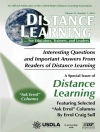‘This book is a fine example of what is needed for distance learning teachers,
administrators, and evaluators throughout the world. It provides good coverage of the timely topics that face distance educators daily. For those considering starting a distance learning course or program, this book would provide a solid footing upon which to make important decisions.’
–REVIEW OF HIGHER EDUCATION
‘The overall strength of this volume is its emphasis on practical considerations that an instructor is likely to encounter in creating a distance course. . . . particularly strong in presenting easily understood principles of good practice for those who must plan and implement distance learning.’
–EVALUATION & PROGRAM PLANNING
What delivery methods are available to make education accessible to a wide variety of potential learners? What are their strengths and weaknesses? How can instructors create effective learning environments in distance courses? What support from administrators and staff is essential? What guidelines are used by accrediting agencies to assure program quality? This highly readable book by three experienced faculty members answers these questions and more. Both theoretical and practical, the book presents proven principles and research-based advice. Drawing upon their experience with a variety of delivery modes, the authors provide readers with tips they can use in designing, implementing, and evaluating distance courses and programs. Instructors and administrators alike will find much valuable assistance, including:
- A wealth of examples and strategies based on field-tested models, student preferences, and the authors′ own extensive experiences
- Comprehensive coverage that addresses available delivery options, factors to consider when selecting a delivery mode, designing a syllabus for a distance course, fostering student learning and development, and providing student support services
- Concrete and practical approaches for assessing student learning, conducting course and program evaluation, and addressing accreditation guidelines
- Summary tips and references to web sites that conclude each chapter provide convenient summaries for readers and guide them to additional resources
- A companion web site that illustrates the text′s coverage with concrete examples
Drawing upon the rich details provided by the authors, faculty and administrators will be able to meet the challenge of developing and evaluating successful distance learning courses and programs.
Cuprins
Acknowledgments
Introduction
Background and Audience
Overview of the Contents
Our Companion Web Site
1. Distance Education: What Is It? And Why Is It Expanding So Rapidly?
Impacts of Technology on Distance Education
The Prevalence of Distance Education in the United States
Societal Changes Contributing to the Growth of Distance Education
The Impact of Distance Education on Traditional Instruction
Criticisms of Distance Education
Conclusion
2. Attracting Students to Distance Learning
How to Assess the Need and Demand for a Distance Program
Target Audience
Instructional Design and Mode of Delivery
Strategies for Marketing Distance Courses and Programs
Specific Ideas for Promoting and Marketing Distance Programs
Conclusion
3. Good Practices in Distance Education: How to Promote Student Learning and Development
The Good Practices
Summary Tips
4. The Syllabus for Distance Learning Courses
What Is a Syllabus?
More Than a List
Outline for a Syllabus: Putting It Together
Other Issues
Summary Tips
5. Delivery Methods for Distance Education
Synchronous or Asynchronous?
Synchronous Delivery Methods
Asynchronous Delivery Methods
Conclusion
6. Selecting Delivery Methods
Fundamental Principles to Observe in Selecting Delivery Methods
A Decision Tree Approach to Selecting a Delivery Method
Conclusion
7. Support Services
Support Services Prior to Enrollment
Support Services for Enrolled Students
Support Services After Course or Program Completion
Summary
8. Ensuring High Completion Rates
The Problem of Retention
Retention in Distance Education Programs
Strategies for Improving Completion Rates
Summary Tips
9. Assessing Learning Outcomes
Guiding Principles
Methods of Assessment
Conclusion
Summary Tips
10. Program Evaluation
Evaluating Program Inputs
Program Processes
Assessing Outcomes
Analysis of Costs and Outcomes
Conclusion
Summary Tips
11. Accrditation
Guidelines for Distance Learning
Providing Evidence Regarding the Program′s Effectiveness in Meeting the Guidelines
Conclusion
Summary Tips
Conclusion
Author Index
Subjedt Index
About the Authors
Despre autor
Lawrence Mc Gahey is Associate Professor, Chair of the Chemistry Department, and Chair of the Natural Sciences Division at The College of St. Scholastica. He has been involved in the development of St. Scholatistca’s distance education program as a member of the Graduate Council and Graduate Curriculum Committee. In addition, he has experience both in developing and incorporating web-based instructional materials into science courses. His research and teaching efforts have been supported by the National Science Foundation, the Research Corporation, and the U.S. Department of Education. He is also a manuscript reviewer and annotator for the Journal of Chemical Education.












